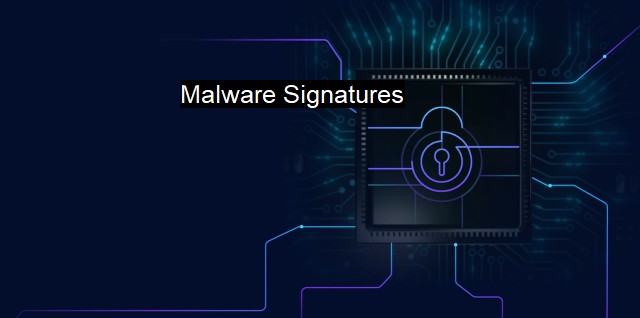What are Malware Signatures?
Understanding Malware Signatures: The Critical Method for Identifying and Removing Cyber Threats in Antivirus (AV) Software
Malware signatures are unique identifying patterns associated with malicious software or files. They are like fingerprints of malign software and are used by cybersecurity professionals and antivirus software to detect and ward off cyber threats. Each distinct form of malware, whether it is a virus, trojan horse, spyware, ransomware, or other malicious software, presents a unique signature that antivirus software can search and scan for.Traditionally, a malware signature was seen as a sequence of bytes seen only in a specific malware and not in any legitimate programmes or files. currently, defining a malware signature isn't as easy, since many modern malwares use obfuscation and disguising techniques which include code encryption, metamorphism, and polymorphism to conceal their payloads in ways which make it difficult for traditional antivirus tools to identify properly.
Each malware can have any possible number of signatures. It is worth noting that, while one malware can have different signatures, each signature is specific to that certain malware and won't match any other examples of malign files or programmes.
a malware signature serves as a formal description that captures essential characteristics of the malware which can be extracted by signature-based detection systems to analyze and compare incoming files or codes with known threats.
Most foundation-level legacy antivirus tools utilise signature-based detection technologies as their principal method of identifying malware. These tools have a database, typically known as a signature database or virus definitions, which holds known malware signatures. This database is updated regularly with new signatures as they are discovered. Upon scanning a programme or file, the tool will examine against its signature database to identify any matches.
The main challenge that arises with signature-based detection has to do with “Zero day” attacks. These are unique threats that are unknown and have never been detected or recognized before. Therefore, they wouldn't have a known signature, making it impossible for signature-based tools to identify them.
Addressing these limitations of signature-based detection systems, antivirus companies and cybersecurity experts devised behavior-based algorithms that consider the behavior of potentially malign programmes or pas in contrast to comparing against a record of known signatures. This type of system is far less effective at identifying established threats, but it offers better protection against newly emerged, unidentified threats.
Despite the issues and limitations, malware signatures remain a crucial component of integrated antivirus systems. Utilised in combination with heuristic and behavior-based strategies, they contribute to an all-encompassing defense mechanism against known and newly emerged threats.
Today, cyber threats are becoming increasingly sophisticated, widespread, and detrimental. With these evolving threats, effective ways to counter this menace must also evolve. As a result, the role of identifying malware signatures as a cornerstone security protocol is foreseen to be increasingly critical.
Malware signature-based detection works most effectively when it's just a piece of a much larger comprehensive security solution that incorporates additional security layers, including behavior-based detection and threat intelligence.
A multilayered approach, involving signature-based detection along with sandboxing, behavior-based threat detection enables a well-rounded active defense that addresses known, unknown, and emerging cyber threats. This way antivirus companies can ensure that they cover as wide a range of potential threats as possible, ranging from widespread, common threats with known signatures to unique, unidentified malwares and everything in between.
Malware signatures are pivotal for maintaining security in our digital world by identifying well-known threats. Despite their limitations, when coupled with modern cybersecurity technology and strategies, these antivirus tools are a crucial part of any business or individual's cybersecurity suite. Evolution and progress in antivirus are welcomed, but it should keep traditional mechanisms, such as malware signature detection, as a part of its roots. Malware signatures continue to play a vital role in antivirus and cybersecurity even today, holding the front line in the battlespace of cyber warfare.

Malware Signatures FAQs
What are malware signatures?
Malware signatures are unique patterns or characteristics that identify malicious software or malware. Antivirus software uses these signatures to detect and block malware from infecting a system.How do antivirus companies create malware signatures?
Antivirus companies use a combination of automated tools and manual analysis to collect information about new viruses and their behavior. Then, they use this information to create unique signatures that can identify the malicious code.Can malware signatures prevent all types of cyberattacks?
No, malware signatures are not foolproof and cannot prevent all types of cyberattacks. Hackers can use various tactics to evade detection by antivirus software, such as encrypting the malware or using polymorphic malware, which changes its code every time it infects a new device.Do I need to update my antivirus software to get the latest malware signatures?
Yes, antivirus software needs to be updated regularly to stay up-to-date with the latest malware signatures. This ensures that the antivirus software can detect and block new and emerging threats that may not have been identified before.| | A | | | B | | | C | | | D | | | E | | | F | | | G | | | H | | | I | | | J | | | K | | | L | | | M | |
| | N | | | O | | | P | | | Q | | | R | | | S | | | T | | | U | | | V | | | W | | | X | | | Y | | | Z | |
| | 1 | | | 2 | | | 3 | | | 4 | | | 7 | | | 8 | | |||||||